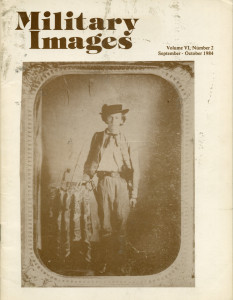The complete issue
Vol. VI, No. 2
(32 pages)
Print edition: Visit our store to check availability
Digital edition: Visit JSTOR.org to purchase
Subscribe to MI
Explore the MI Archives: Browse | Advanced search | Tutorial
Inside
Cover image
The cover of this issue features a quarter-plate ambrotype of an unknown Confederate cavalryman.
Editor’s Desk (p. 1)
The editor takes issue with the practice of “secondhand” readers, those who enjoy Military Images by reading the issues of subscribing friends. He hopes that these readers will extend their support for MI by subscribing on their own and help the magazine to continue to thrive. Additionally, once a year the magazine will now sponsor a listing of “Photos Sought” as a new feature. Subscribers who are looking for a particular image can have their request included.
Mail Call (p. 2)
Several clarifications to information presented in past issues are included in the letters to the editor, who also explains why the magazine is not planning to become a monthly publication. Requests and offers to share images between publications and readers also are included, as are suggestions for future articles.
Passing in Review (p. 3)
Two reviews are presented in this issue of Military Images. The first is United States Military Buttons of the Land Services, 1787-1902 by Martin A. Wyckoff, which presents a system of classifying military buttons. The author is an anthropologist, and the system is geared toward the archaeologist, however the reviewer found this to be an important resource for those interested in the collection of military buttons, who could also use this classification system. The second publication is Marine Badges and Insignia of the World by Burt L. Campbell and Ron Reynolds, which has sections of the book that feature historical insignia from the U.S.M.C from 1840-1940 and a brief section featuring Confederate marine markings.
Vignette: William Catheart, Telegrapher, C.S.A. by Robert L. Hart (p. 4-5)
Having deserted the Hillsborough Military Academy in North Carolina following a request by himself and other cadets to join in the defense of Charleston in 1863, 19 year old telegrapher William Catheart was present at Fort Sumter when it took its harshest attack yet in December 1863. Regulations stated that the telegraph lines were to maintain a constant ticking while under bombardment, with which Catheart endeavored to comply despite having to move around in the burning fort several times. At one point, the telegraph key itself was damaged, and Catheart went to the extreme of putting the ends of the two wires on his moist tongue, reading messages by feeling them. The underwater lines were eventually cut, and Catheart and his supervisor, Joseph W. Kates, spent three frigid nights on a “floating mattress” to find the break. Although not holding military rank, Mr. Catheart was eventually promoted to the position of Superintendent of Military Lines, Charleston at the age of 20 in February 1864.
Tenting on the Old Campground… or Did They?: A Look at Civil War Tents by Harry Roach (pp. 6-9)
The article begins with the recognition that the tent is a constant image in the Civil War collective memory. However, as the article progresses, one soon discovers that the tent was sometimes more of a problem than one might imagine. The Sibley tent (a large conical tent with a central pole which could also hold a Sibley stove in winter) did not last long in the field, as it was cumbersome and needed to be carried by wagons. It, along with the “A” or wedge tent, became more visible in images taken of the rear as the war continued due to the number of wagons and teams needed to transport them. The d’Abri tent required two men to team up and button their tent halves together; there were no poles involved so the soldiers often used their bayonetted muskets as tent poles. Also known as the “dog” or “pup” tent – because that’s all that could fit comfortably inside of one – they were unpopular with the soldiers. Many Confederate units banned tents while in the field altogether, which meant men would bivouac without shelter, as depicted in one drawing that accompanies the article, along with six photographic images.
Brothers at Ball’s Bluff: Luther and Joseph Hapgood, 15th Massachusetts Infantry by Mark Brewer (pp. 10-14)
Two brothers from a farming community in Massachusetts enlisted in the Federal army following the attack of anti-Federal crowds upon Massachusetts soldiers in Baltimore as they made their way by train to Washington. They were like most recruits, and trained earnestly with the hope of defending their country in battle. After the Union losses at First Manassas, their training was hurried and in October, both Luther and Joseph Hapgood’s commander, Colonel Charles Devens, under orders of Colonel Edward Baker who led the brigade, led his 15th Massachusetts forward across the Potomac River to perform a reconnaissance in force a short distance from Leesburg, Virginia. More than half of the 1700 men who made the crossing were casualties, as the Confederates who had been watching the crossing began firing from the cover of nearby woods. Colonel Baker was killed trying to rally his panicked soldiers, Joseph was wounded early and made his way back to the Union side of the river for treatment, while Luther scrambled back up the southern bank to find his missing brother, only to be captured. Luther spent several months in Libby Prison in Richmond; his father was so aggrieved that he lied about his age and enlisted in the 15th Massachusetts and went south to find his son. All three survived, not without some injury, but as time went on, it was the story of the Battle of Ball’s Bluff that was most often retold to their families.
Tipton Panorama Photos of Gettysburg by Kathleen R. Georg (pp. 15-26)
Ten glass plate images taken by Gettysburg photographer William H. Tipton were taken in early l882 to assist French painter Paul Phillippoteaux in his painting of the Gettysburg cyclorama. Guided by resident William Holtzworth, the images in the ten photographs taken that day are presented in this pictorial article, paired with the resulting painted images from the cyclorama. The Tipton photographs can be dated by the wooden poles that line what was to become Hancock Avenue, a means of accommodating visitors to the battlefield while keeping the privately owned farms from being damaged by wayward carriages of visitors. The photographs are labeled with battlefield landmarks, allowing the contemporary reader to orient him/herself to the view being taken.
Vignette: Peter Kiolbassa, Galvanized Yankee by Wayne Rogoski (p. 27)
A young immigrant from Silesia, Peter Kiolbassa settled with his family in Panna Marta, Texas, not far from San Antonio. He quickly added English and Spanish to his native German and Polish, becoming a teacher at a church school prior to the start of the Civil War. He joined initially with a local cavalry brigade which was eventually added to the 14th Texas Cavalry. He was taken as a prisoner of war when General John A. McClernand’s forces stormed and took Arkansas Post in January 1863. Kiolbassa, along with several others, took the oath of allegiance to the Union, becoming “Galvanized Yankees: as a result. He was allowed to enlist in Company D, 16th Illinois Cavalry and served in both the Knoxville and Atlanta campaigns. Over time, Kiolbassa was promoted to captain of Company E, 16th U.S. Colored Cavalry, seeing action in Kentucky and Arkansas. During leave in February 1864, Kiolbassa became involved in the development of the first Polish Roman Catholic Church in Chicago, St. Stanislaus Kosta, which still stands today. Kiolabassa made Chicago his adopted home, living out the rest of his life in civic and political service to his community.
Stragglers (pp. 28-30)
A tintype of a Federal trooper holding aim on a Confederate prisoner with what appears to be a Navy Colt, an albumen image of a Confederate from Georgia tinted in butternut not gray, and a 50 year “before and after” pair of images of Elijah Tillotson of Osceola, Iowa are the more serious images shared by the readers of Military Images. The more humorous includes a Civil War era carte de visite of a soldier contemplating the appearance of an infant in a cradle and wondering “Who’s been here since Ise been gone?” along with a latrine image from around 1898.
Back Image
Five soldiers, likely from the Spanish-American War or World War One, are being taught to use cameras by a civilian.





































